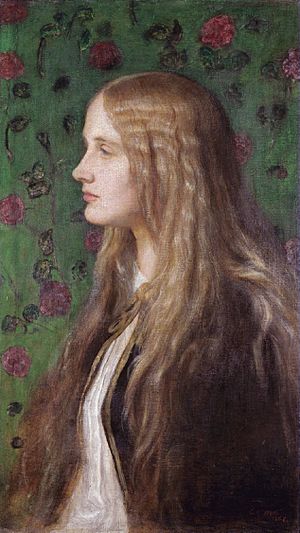Edith Bulwer-Lytton, Countess of Lytton facts for kids
Quick facts for kids
The Countess of Lytton
VA CI
|
|
|---|---|

Portrait by George Frederic Watts (1862)
|
|
| Born |
Edith Villiers
15 September 1841 |
| Died | 17 September 1936 (aged 95) |
| Resting place | Knebworth, Hertfordshire, England, UK |
| Nationality | British |
| Other names | Edith Bulwer-Lytton, Baroness of Lytton |
| Known for | Vicereine of India |
| Spouse(s) |
Robert Bulwer-Lytton, 1st Earl of Lytton
(m. 1864; died 1891) |
| Children | 7 |
| Parent(s) | Edward Ernest Villiers Elizabeth Charlotte Liddell |
| Relatives | Villiers family |
Edith Bulwer-Lytton, Countess of Lytton (born Villiers; 15 September 1841 – 17 September 1936) was an important British lady. She was the wife of Robert Bulwer-Lytton, 1st Earl of Lytton. This meant she became the vicereine of India when he was in charge there.
After her husband passed away, she worked for Queen Victoria at court. One of her children was Lady Constance Bulwer-Lytton, who became a famous supporter of women's right to vote.
Contents
Early Life and Marriage
Edith Villiers was born on 15 September 1841. She came from the important Villiers family. Her father was Edward Ernest Villiers and her mother was Elizabeth Charlotte Liddell. She was also the niece of a well-known Earl, George Villiers, 4th Earl of Clarendon.
A famous artist named George Frederic Watts painted her picture when she was 21. At that time, she was the only one of her sisters who was not yet married. Edith had learned dancing, music, and art. However, she did not have a formal school education.
Edith married Robert Bulwer-Lytton on 4 October 1864. Robert later became the 1st Earl of Lytton. Edith brought a good income to their marriage. Robert was a diplomat, which means he worked for his country in other nations. His father, Edward Bulwer-Lytton, was a famous writer. He wanted Robert to be a diplomat.
Edith traveled with her husband during his work as a diplomat. Several of their children were born in different countries. They had seven children:
- Edward Rowland John Bulwer-Lytton (1865–1871)
- Lady Elizabeth Edith "Betty" Bulwer-Lytton (1867–1942)
- Lady Constance Georgina Bulwer-Lytton (1869–1923), who became a British activist for women's voting rights.
- Hon. Henry Meredith Edward Bulwer-Lytton (1872–1874)
- Lady Emily Bulwer-Lytton (1874–1964), who married the architect Edwin Lutyens.
- Victor Bulwer-Lytton, 2nd Earl of Lytton (1876–1947)
- Neville Bulwer-Lytton, 3rd Earl of Lytton (1879–1951)
Vicereine of India
Edith's husband served as the Viceroy of India from 1876 to 1880. This meant Edith was the Vicereine, the highest-ranking woman in India. In 1876, she gave birth to her son Victor in India. Her first two sons had died as babies. Victor and her last child, Neville, would later become Earls.
A grand event called the Delhi Durbar took place on 1 January 1877. It was held to announce that Queen Victoria was now the Empress of India. The next year, Edith received a special honor called the Imperial Order of the Crown of India. She also received the Royal Order of Victoria and Albert.
Edith and her daughters helped make the court in India more stylish, like the courts in Europe. They even ordered fashions from Paris. Edith was also known for supporting education for women in India. Her daughter Emily kept an interest in Indian culture after they returned to England.
When Edith's husband finished his time as Viceroy in 1880, he was given the title of Earl.
Life in Paris and at Court
In 1887, Edith's husband became the British Ambassador in Paris, France. Sadly, he passed away suddenly in Paris in 1891. He was given a rare state funeral in France, which means the French government honored him greatly. Edith and her five surviving children were the main mourners.
After her husband's death, Edith had less money. In 1895, she became a Lady-in-Waiting to Queen Victoria. This important job meant she helped the Queen. She was personally asked by the Queen to take on this role. In 1897, she attended a grand costume party for the Queen's Diamond Jubilee.
When Queen Victoria died, Edith rode with the Queen's body during the funeral journey. She then continued to serve as a Lady-in-Waiting for Queen Alexandra until she retired in 1905.
Retirement and Legacy
Edith lived for more than thirty years after she retired. She lived at Homewood, a house on her family's estate in Knebworth, Hertfordshire. Her son-in-law, Sir Edwin Lutyens, designed the house.
Her daughter Constance, the suffragette, had a stroke in 1912. Constance then came to live at Homewood until shortly before she passed away in 1923.
Edith and Robert had five children who lived to become adults and had important lives. Edith also sat for a famous painting by George Frederic Watts. Even though she did not have a formal education, she played an important role in society and supported important causes.
Images for kids
-
Lady Edith Villiers dressed as Lady Melbourne for a costume party at Devonshire House (1897)




